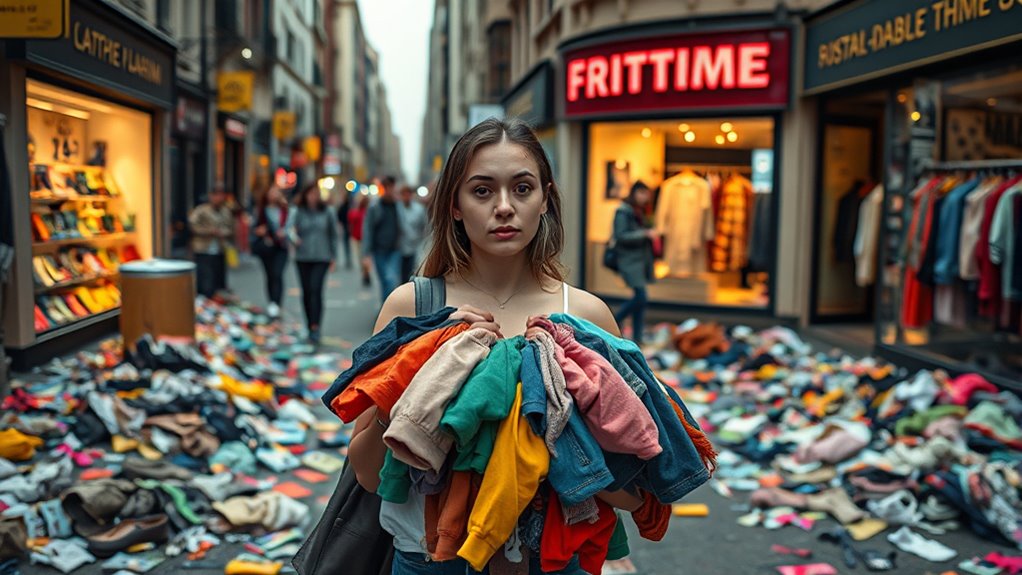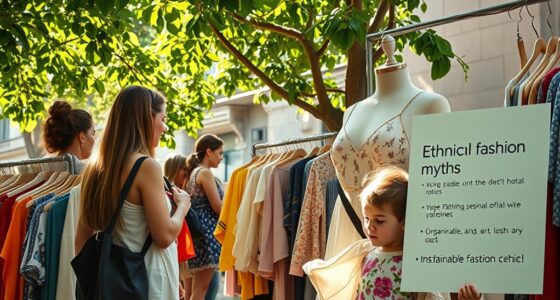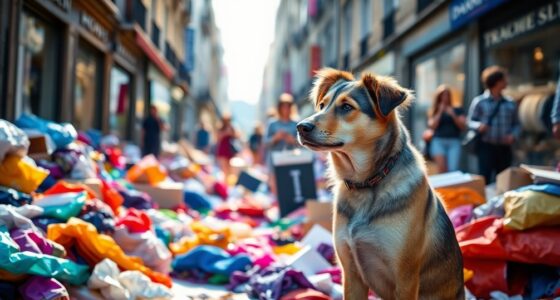Fast fashion severely harms the environment, contributing about 10% of global carbon emissions and creating massive textile waste. With millions of tons ending up in landfills, the impact is undeniable. Workers face unsafe conditions, with many earning less than a living wage. To avoid this cycle, focus on mindful shopping: choose quality over quantity, explore secondhand options, and support sustainable brands. By understanding these issues, you'll discover more ways to make a difference in the fashion industry.
Key Takeaways
- Fast fashion contributes significantly to global carbon emissions and creates immense textile waste, with only 14.7% of textiles recycled in 2018.
- Workers in developing countries face unsafe conditions and low wages, with many experiencing gender-based harassment and mental health issues.
- Opt for sustainable fashion by choosing organic materials, supporting fair labor practices, and prioritizing quality over quantity in clothing purchases.
- Establish a no-buy period to reassess wardrobe needs, and consider renting or buying secondhand to reduce impulse buying and waste.
- Research brands for sustainability claims and use platforms like Good On You for ethical ratings to guide mindful shopping decisions.
Understanding Fast Fashion and Its Environmental Consequences

As the fashion industry evolves, fast fashion has emerged as a dominant force, reshaping how you consume clothing. This business model thrives on quick production cycles, with some designs hitting the market in just 10 days. Major brands like Zara, Shein, and H&M cater to your desire for trendy, affordable garments.
However, this convenience comes at a cost; fast fashion contributes around 10% of global carbon emissions, making it a significant polluter. Additionally, it consumes vast amounts of water and relies heavily on synthetic materials, which are non-biodegradable. Sustainable practices are increasingly being adopted by some brands to counteract these negative effects on the environment.
As you embrace these styles, it's crucial to recognize the environmental impact and consider alternative options that promote sustainability and reduce harm to our planet. Renewable energy innovations can help mitigate carbon emissions and provide more sustainable industrial practices in the fashion sector.
The Waste Crisis: Textile Waste and Its Management

While many of us enjoy the thrill of new fashion, the reality of textile waste is hard to ignore. The average American tosses out over 80 pounds of clothing each year, contributing to a staggering 17 million tons of textile waste in the U.S. alone. This waste not only occupies landfills but also emits greenhouse gases and pollutes our waters. In 2018, only 14.7% of textiles were recycled, leaving millions of tons to decay. Financial considerations for end-of-life care can also apply to how we manage our clothing waste, as it reflects broader sustainability issues. Decluttering our wardrobes can significantly reduce stress levels and help you make more mindful fashion choices. Additionally, practicing investment diversification in sustainable fashion brands can lead to more environmentally friendly consumption habits. By incorporating natural elements into our fashion habits, we can further promote sustainability and reduce our environmental impact. Moreover, adopting smart shopping strategies can help you find eco-friendly options while saving money. You can help by embracing sustainable practices—buying secondhand, mending clothes, or supporting brands with eco-friendly initiatives. By making conscious choices, you can combat the waste crisis and encourage a shift towards a more sustainable fashion industry.
Your actions matter!
The Human Cost: Impact on Workers in Developing Countries
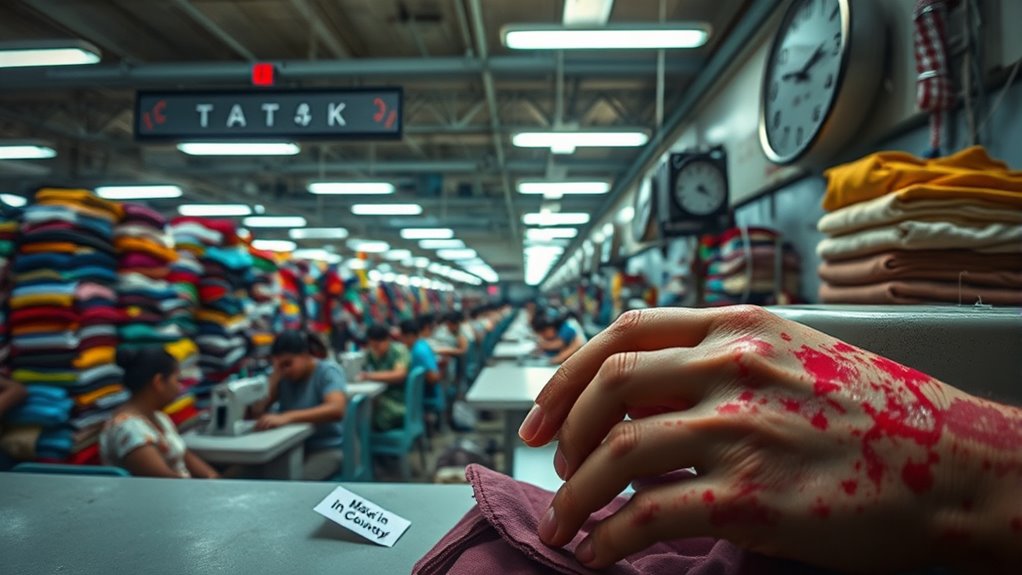
Fast fashion's allure often masks the harsh realities faced by millions of workers in developing countries. You mightn't realize that around 75 million factory workers toil under unsafe conditions, with less than 2% earning a living wage.
Most of these workers are women, who encounter systemic sexism, wage theft, and exhaustion due to grueling production cycles. Long hours and hazardous environments, like those exposed during the Rana Plaza disaster, are commonplace. Studies have shown that many of these workers may also experience mental health issues due to the stress and trauma of their working conditions. Additionally, adequate sleep is often unattainable for these workers, further exacerbating their mental and physical health challenges. The emotional distress faced by these workers can lead to higher rates of anxiety that impact their overall well-being. Furthermore, the lack of regular veterinary check-ups for workers' health can lead to untreated medical issues that deteriorate their condition over time.
Many factories lack safety measures, leading to accidents and health issues from toxic chemicals. Furthermore, gender-based harassment is prevalent, adding to the mental and physical toll. Understanding these conditions is vital for making informed choices as a consumer and advocating for better labor practices. Additionally, recognizing the importance of fair treatment in labor practices can help drive positive change in the industry.
Social Implications: Fashion, Class, and Consumerism
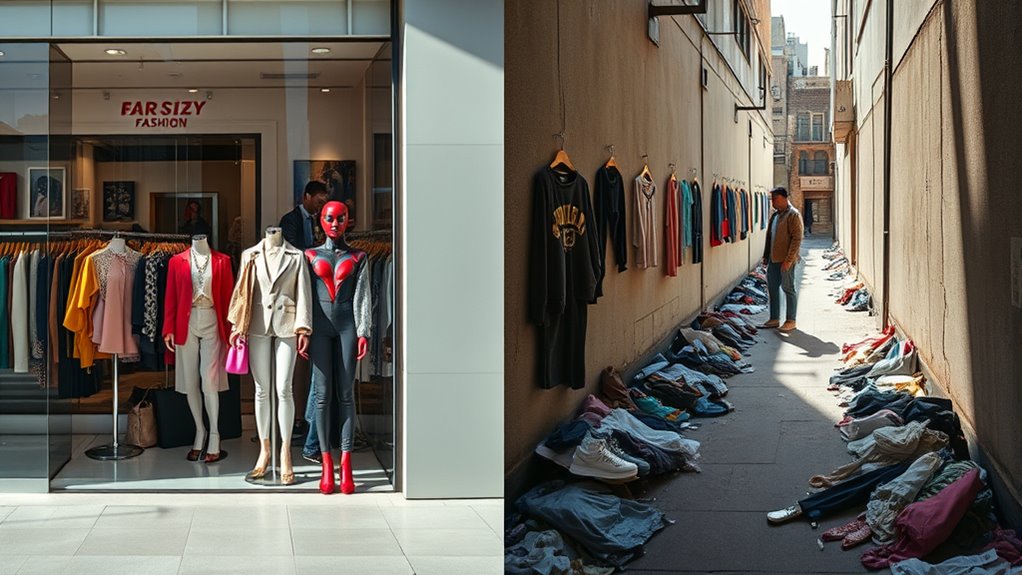
Fashion plays a pivotal role in shaping social dynamics, influencing class perceptions and consumer behavior. Fast fashion allows you to showcase wealth and status through trendy clothing, while simultaneously bridging gaps between income groups by offering affordable options.
However, this model promotes a culture of disposability, encouraging you to frequently purchase and discard items. Social media amplifies this consumerism, with influencers driving demand for the latest trends. Many consumers are now seeking to integrate smart home device integration into their lives, reflecting a growing awareness of sustainability. The beauty industry is also adapting to this shift, with a rise in clean beauty products that prioritize non-toxic ingredients. Moreover, understanding the importance of advance directives can help you make informed decisions about your financial and legal matters as you navigate the implications of consumerism. Additionally, the sustainable fashion movement is gaining momentum, urging consumers to prioritize ethical choices in their clothing purchases.
While you may feel pressure to stay fashionable, this often overshadows concerns about sustainability and social justice. The economic benefits of fast fashion come at a significant cost to the environment and social well-being, making it crucial to reflect on your choices and their broader implications in society. Many brands are now focusing on sustainable practices that prioritize eco-friendly materials and ethical labor standards.
Exploring Sustainable Fashion: Alternatives to Fast Fashion
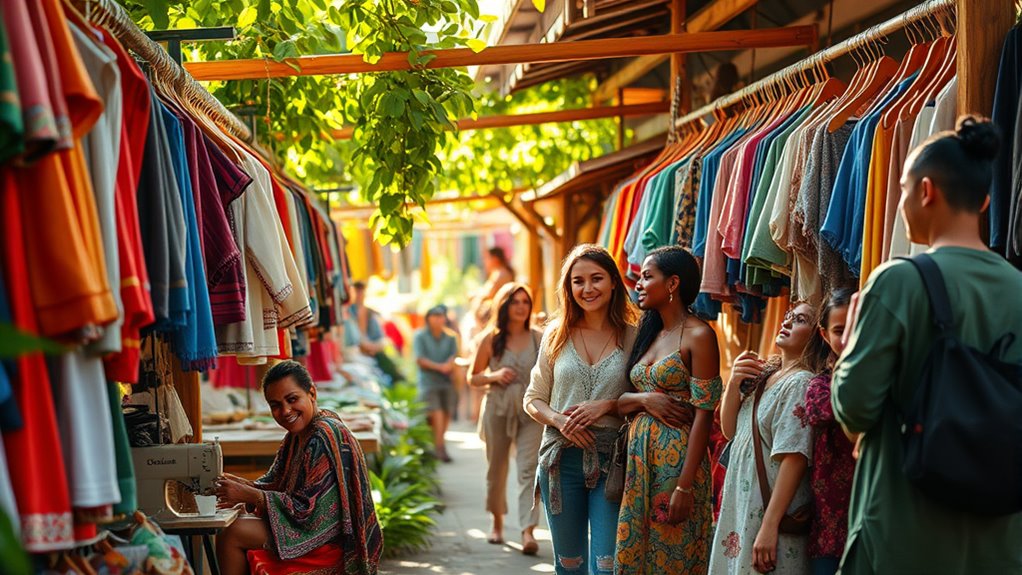
As you seek alternatives to fast fashion, exploring sustainable fashion becomes essential for making mindful choices. Sustainable fashion prioritizes minimal environmental impact by using natural, organic materials and promoting fair labor practices. Incorporating high fiber foods into your diet, like chia seeds, can also support a healthier lifestyle while you transition to sustainable choices. Chia seeds are rich in fiber, which aids digestion and promotes a feeling of fullness, making them a beneficial addition to your meals. Additionally, chia seeds can help promote bowel regularity, enhancing your overall digestive health. Investing in solar energy solutions can also reduce your carbon footprint while supporting sustainable living.
Opt for brands that utilize biodegradable fabrics like organic cotton and linen, which help reduce waste and pollution. Embrace slow fashion, emphasizing quality over quantity, as this leads to longer-lasting garments and less frequent purchases.
Consider upcycling or participating in clothing swaps to minimize waste. Brands like Patagonia offer recycling programs, ensuring garments don't end up in landfills. Incorporating natural materials into your wardrobe not only supports sustainability but also enhances the unique charm of your clothing.
Strategies for Avoiding Fast Fashion

While navigating the fashion landscape, you can adopt specific strategies to avoid falling into the fast fashion trap.
First, recognize common fast fashion brands like H&M and Shein, and watch for suspiciously low prices that often signal compromised quality. Be cautious of brands touting unverified sustainability claims, and research their supply chains for transparency. Additionally, consider that freshly squeezed juices are often more nutritious than processed options, just as high-quality clothing is typically more durable than fast fashion. Understanding local building codes can also help you make informed decisions when purchasing clothing or accessories that may require special care or maintenance. For example, investing in quality pieces can be likened to using hydrocolloid technology for targeted treatments in skincare, promoting long-term benefits over quick fixes. In addition, consider that many states, like Georgia, see a high number of divorce cases annually, which highlights the importance of making thoughtful choices in all aspects of life, including fashion.
Utilize platforms like Good On You to check ethical ratings. When shopping, consider buying secondhand through sites like ThredUp, focusing on quality over quantity.
Establish a no-buy period to reassess your wardrobe needs, track usage to refine choices, and avoid impulse buys.
Finally, consider renting clothes for special occasions instead of purchasing. These steps can help you make more sustainable fashion choices. Additionally, understanding interior design principles can influence your choice of clothing and accessories that complement your living space, promoting a more cohesive and thoughtful lifestyle.
The Future of Fashion: Encouraging Sustainable Practices
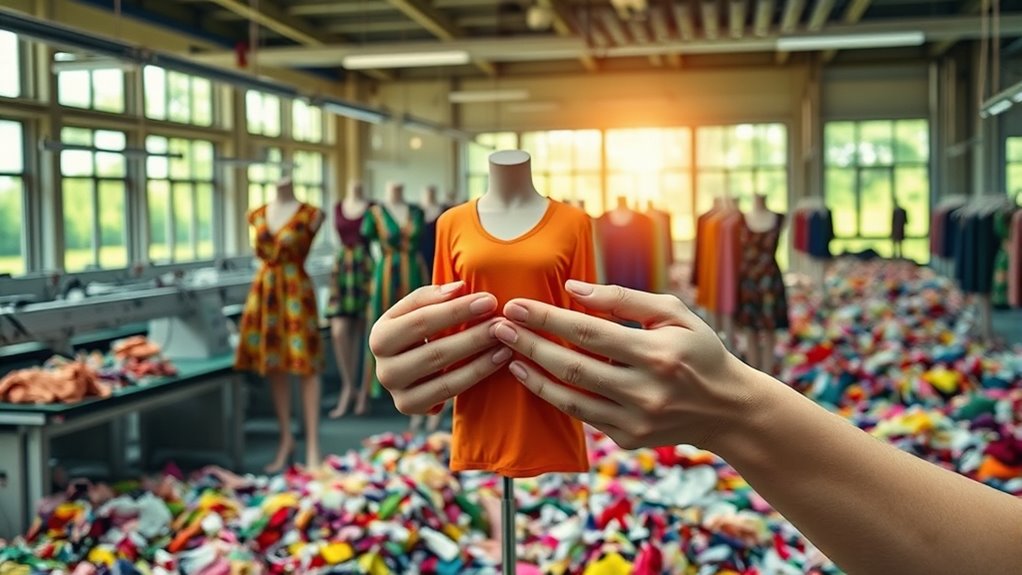
To pave the way for a more sustainable future in fashion, brands must embrace innovative practices that prioritize environmental responsibility. You can support this shift by choosing circular fashion pieces, which emphasize reusable and recyclable materials. Look for clothing made from organic and plant-based fabrics, reducing the overall environmental footprint. Additionally, consider the nutritional benefits of plant-based diets that emphasize sustainability and health, mirroring the values of sustainable fashion. Incorporating chia seeds into your diet, for instance, not only boosts nutrition but also aligns with eco-friendly eating practices. Understanding legalities and zoning regulations in sustainable practices can further enhance the industry's accountability. Transparency in production is key; brands utilizing blockchain technology can provide insight into garment origins, promoting ethical sourcing. As you shop, consider investing in higher-quality, longer-lasting items to combat the fast fashion cycle. Technology, like AI-driven production and 3D printing, helps minimize waste, while your growing awareness can drive demand for sustainable practices. Together, we can encourage a more responsible fashion industry.
Frequently Asked Questions
How Can I Identify Sustainable Clothing Brands?
To identify sustainable clothing brands, start by researching materials like organic cotton, Tencel, and recycled fabrics.
Look for brands that prioritize fair production practices, ensuring good working conditions and transparency in their supply chains.
Check for third-party certifications that validate their claims.
Use platforms like Good On You to compare brands based on environmental and social impact.
Stay informed and educate yourself, making conscious choices that align with your values.
What Are the Benefits of Secondhand Shopping?
Imagine walking through a treasure-filled thrift store, where each rack holds stories waiting to be discovered.
Secondhand shopping offers you incredible savings, allowing you to snag high-quality items at a fraction of the price.
You'll not only save money, but you'll also help reduce waste and support sustainable practices.
Plus, with a growing online market, finding that perfect vintage piece has never been easier or more rewarding.
Embrace the thrill of the hunt!
How Do Microplastics Impact Marine Life?
Microplastics impact marine life significantly.
When you consider that marine animals ingest these tiny particles, mistaking them for food, it's alarming. This ingestion can harm their health, disrupt their nutrient cycles, and even affect the entire food chain.
As microplastics accumulate, they can lead to reduced oxygen levels and degraded habitats.
You might also be concerned about the implications for human health since we consume fish that contain these harmful particles.
Can Fast Fashion Be Completely Eliminated?
You might wonder if fast fashion can be completely eliminated.
While it's challenging due to economic factors and consumer behavior, it's not impossible to significantly reduce its impact.
Changes in production methods, increased awareness of sustainability, and a shift in consumer preferences can lead to a more sustainable fashion industry.
What Role Do Consumers Play in Sustainable Fashion?
Think of yourself as a superhero for the planet, wielding the power of choice.
You play a crucial role in sustainable fashion by supporting brands that prioritize eco-friendly practices and transparent supply chains.
When you educate yourself about sustainable materials, you make informed decisions that drive demand for ethical options.
Conclusion
If you think fast fashion is harmless, think again! It's wreaking havoc on our planet and exploiting vulnerable workers at an alarming rate. But you can be a superhero for sustainable fashion! By making conscious choices, you can save the Earth from drowning in textile waste and support fair labor practices. Your wardrobe can transform from a fast fashion nightmare into a beacon of hope. So, ditch the trends and embrace a style that truly cares—because the world needs you!
